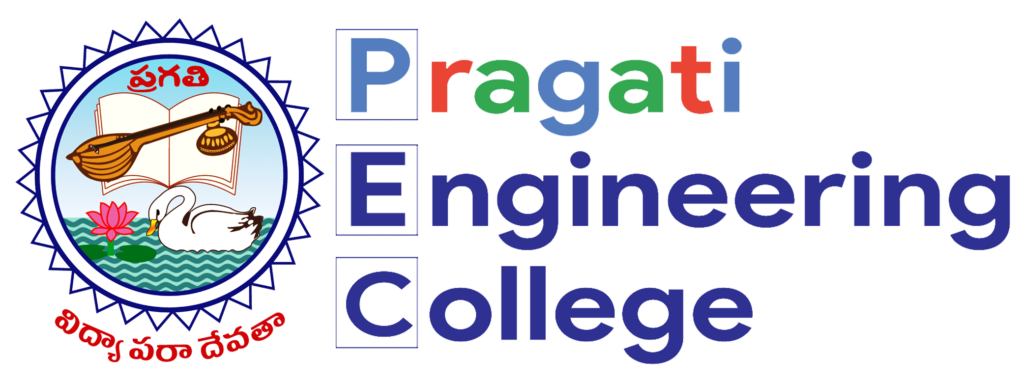BEST PRACTICES
BEST PRACTICES
Best Practice 1: Practical Implementation of Outcome-Based Education (OBE)
- Title of the Practice:
Practical Implementation of Outcome-Based Education (OBE) - Objectives of the Practice:
- To align teaching, learning, and assessment practices with defined learning outcomes for each program.
- To enhance the skills and competencies of students to meet industry standards and requirements.
- To ensure continuous quality improvement by assessing and measuring student performance in alignment with defined outcomes.
- To promote a student-centered learning environment that fosters critical thinking, problem-solving, and creativity.
- The Context:
The shift from traditional education to OBE requires a structured approach to ensure learning outcomes align with program goals, industry expectations, and accreditation standards. Pragati Engineering College recognized the need for an adaptable OBE framework that could be practically implemented across departments. The challenge lay in designing curricula, assessments, and faculty development programs that directly support OBE principles. - The Practice:
- Curriculum Mapping: Program outcomes (POs), course outcomes (COs), and specific learning outcomes were mapped in alignment with industry needs and accreditation guidelines.
- Faculty Development Programs (FDPs): Regular FDPs were conducted to train faculty on OBE concepts, assessment methods, and innovative teaching strategies.
- Assessment and Evaluation Tools: A range of tools, including rubrics, were developed to measure the attainment of COs and POs. Assessment methods were designed to evaluate critical thinking, practical skills, and conceptual understanding.
- Continuous Improvement Cycle: The college established a feedback loop where performance data from assessments is analyzed, and improvements are made to teaching methods and content delivery.
- Evidence of Success:
- The college has witnessed a significant improvement in students’ performance in both academic and industry placements, with 80% of students successfully placed in top companies.
- Students have shown enhanced problem-solving skills, with increased participation in national-level competitions and hackathons.
- Positive feedback from employers regarding graduates’ job readiness and technical competence, validating the impact of OBE on employability.
- An increase in program-specific accreditation and recognition, underscoring the success of the OBE framework.
- Problems Encountered and Resources Required:
- Challenges: Resistance to change among some faculty members, initial difficulties in developing outcome-based assessments, and balancing OBE requirements with existing curriculum mandates.
- Resources Required: Dedicated time for faculty training on OBE, software for data analysis of outcomes, and increased collaboration with industry for realistic outcome alignment.
Best Practice 2: Quality Assurance in Teaching-Learning
- Title of the Practice: Quality Assurance in Teaching-Learning
- Objectives of the Practice:
- To ensure effective teaching-learning processes that align with global standards.
- To enhance the competency and teaching skills of faculty members.
- To implement continuous assessment and improvement of teaching methodologies.
- To ensure that students are well-prepared with both theoretical knowledge and practical skills for industry readiness.
- To utilize technology and feedback for enhancing teaching effectiveness and student engagement.
- The Context: Pragati Engineering College recognizes that quality education is the cornerstone of student success. The changing industry requirements demand that faculty members continuously adapt and improve their teaching methods. With a large student base and diverse learning needs, the institution identified a need for robust quality assurance in teaching-learning practices. This practice is focused on delivering effective and consistent teaching methods, supported by a systematic feedback and evaluation mechanism.
- The Practice:
- Training and Development: Faculty members undergo regular training in new teaching methodologies, curriculum updates, and technological tools like Learning Management Systems (LMS) and virtual classrooms.
- Use of Technology: Implementing NPTEL and AICTE Eduskill modules to supplement classroom learning, giving students access to industry-aligned courses.
- Feedback Mechanism: Regular feedback from students is collected through anonymous surveys, peer reviews, and classroom observations to ensure continuous improvement.
- Outcome-Based Education (OBE): The college has adopted OBE frameworks, setting clear learning outcomes for every course and conducting assessments to ensure these outcomes are met.
- Mentorship Program: Faculty members mentor students on both academic and personal fronts to enhance learning and address any challenges they may face.
- Evidence of Success:
- Pragati Engineering College has observed significant improvements in student performance and engagement, reflected in improved exam scores and participation in academic activities.
- Faculty feedback has led to measurable improvements in teaching effectiveness, with faculty members adopting more student-centered approaches.
- The quality assurance measures have also contributed to high placement rates (80%), as students emerge well-prepared with industry-relevant skills.
- Student participation in NPTEL and AICTE Eduskill programs has significantly increased, showcasing the effectiveness of self-learning and blended learning techniques promoted through the practice.
- Problems Encountered and Resources Required:
- Challenges: Initial resistance to change among faculty and students, adapting to new technologies, and ensuring all students have access to resources.
- Resources Required: Regular workshops and training sessions, software and hardware upgrades for blended learning, and a dedicated team for continuous assessment and feedback management.
